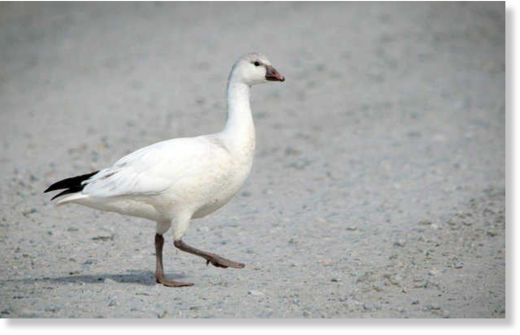2 Rare Arctic ross's geese turn up in Hardeeville, South Carolina
When avid birdwatcher Carol Clemens had a chance to see a rare species -- one that usually migrates only along the West Coast -- just 45 minutes from her Hilton Head Island home, she couldn't pass it up.
A Ross's goose, similar to but smaller than a snow goose, had been spotted in the Savannah National Wildlife Refuge near Hardeeville, and Clemens hopped in her car almost as soon as she heard.
"This bird is so unusual that if I hadn't called my friend to go out and see it, then it would have been a lost opportunity," said Clemens, membership co-chairwoman of the Hilton Head Island Audubon Society.
"We were hoping to get a glimpse of the goose, but thought that it would be just a white speck on the horizon," she added. "But then we got almost 10 feet away and could really admire it."
Sadly, the visit by both the goose and its apparent companion proved short-lived -- both have been found dead, within about 10 days of their arrival, according to refuge spokeswoman Monica Harris.
The first goose is believed to have been killed last week by a bobcat, Harris said. The second was found dead Monday morning, though the cause is not yet known.
It might have been a "depressional loss," Harris said, as Ross's geese mate for life.
The rare pair drew much attention after they were first spotted about Nov. 15.
The species normally breed in the central Arctic, then migrate to central California or Texas for winter, according to the Cornell Lab of Ornithology. The geese -- which have a small but growing population -- are rarely seen east of the Mississippi River.
That's part of what makes this sighting so special, Clemens said.
She keeps yearly lists of the birds she sees, hoping to add one or two new species each year. The Ross's goose sighting was a first for her, and one of her favorite sightings since she began birding nearly 10 years ago, she said.
"The goose was beautiful -- very white, very calm and did not seem to be bothered by people," said Clemens, adding that as many as eight people stopped to take pictures when she was there.
Although the birds' deaths are a tragedy, their visit to the area is indicative of a larger trend of more and greater varieties of birds visiting the Lowcountry. This year is shaping up to be one of the best in years for Lowcountry birders, according to several wildlife specialists. They are spotting songbirds, wood storks, black skimmers, painted buntings, ducks, thrushes and warblers.
Just last month, Clemens said she spotted another rare bird to the area, the bay breasted warbler, in her backyard.
Across the country, many species are declining because of habitat and food-source loss, human disturbance, and new predators, such as domestic cats.
But that decline isn't as apparent in the Lowcountry, perhaps because of the area's vast expanses of open and protected land and shore. Not only are these conserved acres used by native species, they also serve as a refuge for species forced from their habitats, according to Clemson University ornithology professor emeritus Sid Gauthreaux.
The Lowcountry's cooler weather in recent weeks might also have brought different species to the area, Clemens said.



0 reacties:
Post a Comment